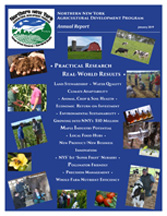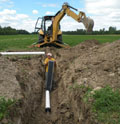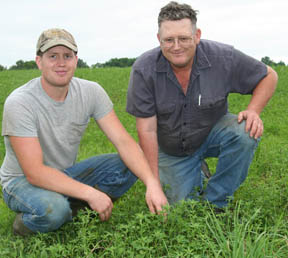 Northern N.Y.; January 9, 2019. The farmer-driven Northern New York Agricultural Development Program has posted its annual report at www.nnyagdev.org. The 12-page document highlights the Program’s practical research and real-world results in terms of the local and statewide economic, agronomic and environmental stewardship value.
Northern N.Y.; January 9, 2019. The farmer-driven Northern New York Agricultural Development Program has posted its annual report at www.nnyagdev.org. The 12-page document highlights the Program’s practical research and real-world results in terms of the local and statewide economic, agronomic and environmental stewardship value.
The diversity of soils, micro-climates and agricultural sectors across the six northern counties of New York State make Northern New York an ideal research area.
Testimonies from farmers and research specialists offer personal and professional insight into the value of the NNYADP projects’ science-based, field-tested results focused on enhancing dairy, crop, maple, fruit and vegetable production and efficient return-on-investment as well as soil health and water quality management practices.
Multi-year NNYADP projects are progressively building farm- and field-specific datasets and adding critical mass to regional, state and Northeast datasets to form the science-based basis for whole-farm nutrient mass balancing. This work demonstrates how farmers can more efficiently apply fertilizer and manure to meet natural resource stewardship goals without losing crop yield or quality.
 The NNYADP has commissioned a first-of-its-kind project for New York State. Miner Institute has begun evaluating how the use of tile drainage interacts with soil, crops, and water resources in a project located along Lake Champlain. The work includes a comparison of water quality and crop yield and quality from tiled and naturally draining fields.
The NNYADP has commissioned a first-of-its-kind project for New York State. Miner Institute has begun evaluating how the use of tile drainage interacts with soil, crops, and water resources in a project located along Lake Champlain. The work includes a comparison of water quality and crop yield and quality from tiled and naturally draining fields.
With the same precision management goal, the NNYADP farmer committee is credited for its acumen in identifying the need to reevaluate nutrient application guidelines due to advances in corn breeding and production practices. This work helps farmers reduce the use of fertilizer and manure resources where not needed and apply such nutrients as nitrogen and phosphorus only where crop uptake and benefit are expected.
 Recent NNYADP projects have addressed challenges and opportunities related to climate adaptability for cows, crops, and conservation; as well as developing birch syrup as a niche product to help Northern NY maple producers grow into the region’s $10 million annual sales potential as identified by Cornell University.
Recent NNYADP projects have addressed challenges and opportunities related to climate adaptability for cows, crops, and conservation; as well as developing birch syrup as a niche product to help Northern NY maple producers grow into the region’s $10 million annual sales potential as identified by Cornell University.
Other NNYADP research is building on food buyer, consumer, and farmer interest expressed in the NNY local food hub feasibility survey, and providing valuable pollinator-friendly information to the emerging NY honey industry and to NY apple growers.
The cold-hardy grape research nursery at Willsboro has just begun evaluating new varieties suggested by growers, plant breeders and the leading academic programs for production in New York State, and early commercial-scale production data from the “super fruit” Juneberry nursery at Willsboro is now encouraging on-farm trials.
 As evidence of the combined long-term commitment by New York State and the NNYADP to funding and finding a solution to the devastating alfalfa snout beetle, the annual report notes that the biocontrol application developed in NNY has not only restored alfalfa production regionally but is now finding use to manage pests in other crops across New York State and elsewhere in the U.S.
As evidence of the combined long-term commitment by New York State and the NNYADP to funding and finding a solution to the devastating alfalfa snout beetle, the annual report notes that the biocontrol application developed in NNY has not only restored alfalfa production regionally but is now finding use to manage pests in other crops across New York State and elsewhere in the U.S.
Funding for the Northern New York Agricultural Development Program is supported by the New York State Senate and administered by the New York State Department of Agriculture and Markets.